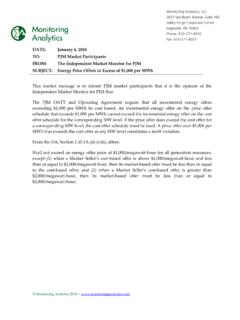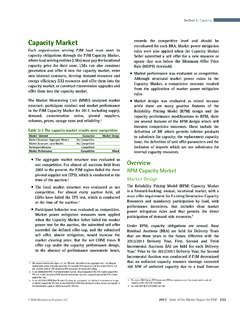Transcription of Ancillary Service Markets - Monitoring Analytics
1 Section 9 Ancillary services Ancillary Service Markets competitive offers when the three pivotal supplier test is failed and there was no evidence of generation owners engaging in anti-competitive The United States Federal Energy Regulatory Commission (FERC) defined behavior. market performance was evaluated as indeterminate, after the introduction six Ancillary services in Order No. 888: 1) scheduling, system control and dispatch; 2) reactive supply and voltage control from generation Service ; 3). of the new market design. It is too early to reach a definitive conclusion regulation and frequency response Service ; 4) energy imbalance Service ; 5).
2 About performance under the new market design because important operating reserve synchronized reserve Service ; and 6) operating reserve . parts of the design is inefficient and because there is not yet enough supplemental reserve Of these, PJM currently provides regulation, information on performance. energy imbalance, synchronized reserve, and operating reserve supplemental reserve services through market -based mechanisms. PJM provides energy market design was evaluated as indeterminate, after the introduction of imbalance Service through the Real-Time Energy market .
3 PJM provides the the new market design. While the market design continues to include remaining Ancillary services on a cost basis. Although not defined by the the incorrect definition of opportunity cost, overall the changes were FERC as an Ancillary Service , black start Service plays a comparable role. Black positive. The market design also includes the incorrect definition of the start Service is provided on the basis of incentive rates or marginal benefits factor for purposes of settlement. It is too early to reach a definitive conclusion about the new market design because there is not The market Monitoring Unit (MMU) analyzed measures of market structure, yet enough information about actual implementation of the design.
4 Conduct and performance for the PJM Regulation market , the two regional Synchronized Reserve and Non-Synchronized Reserve Markets , and the PJM Table 9 2 The Synchronized Reserve Markets results were competitive DASR market for the first six months of 2013. market Element Evaluation market Design market Structure: Regional Markets Not Competitive Table 9 1 The Regulation market results were indeterminate for January Participant Behavior Competitive market Performance Competitive Effective through June, 2013. January through June 2013. market Element market Structure Evaluation Not Competitive market Design The Synchronized Reserve market structure was evaluated as not competitive because of high levels of supplier concentration.
5 The MMU. Participant Behavior Competitive market Performance To Be Determined To Be Determined estimates that the Synchronized Reserve market would have had one or more pivotal suppliers which failed the three pivotal supplier test in percent of the hours in January through June, 2013. The Regulation market structure was evaluated as not competitive for Participant behavior was evaluated as competitive because the market January through June 2013 because the Regulation market had one or rules require competitive, cost based offers. more pivotal suppliers which failed PJM's three pivotal supplier (TPS) test in 90 percent of the hours in January through June, 2013.
6 market performance was evaluated as competitive because the interaction Participant behavior in the Regulation market was evaluated as competitive of the participant behavior with the market design results in competitive prices. for January through June, 2013 because market power mitigation requires 1 75 FERC 61,080 (1996). 2 For more details, see the 2012 State of the market Report for PJM, Volume II, Section 9, Ancillary Service Markets .. 2013 Monitoring Analytics , LLC 2013 Quarterly State of the market Report for PJM: January through June 223. 2013 Quarterly State of the market Report for PJM: January through June market design was evaluated as effective because market power mitigation Overview rules result in competitive outcomes despite high levels of supplier concentration.
7 Regulation market The PJM Regulation market continues to be operated as a single market . Table 9 3 The Day-Ahead Scheduling Reserve market results were competitive market Element Evaluation market Design market Structure Supply. In January through June 2013, the supply of offered and eligible market Structure Competitive Participant Behavior Mixed market Performance Competitive Mixed regulation in PJM was both stable and adequate. The ratio of offered and eligible regulation to regulation required averaged This is a The Day-Ahead Scheduling Reserve market structure was evaluated as percent increase over January through June 2012 when the ratio was competitive because market participants did not fail the three pivotal supplier test.
8 demand . The on-peak regulation requirement is equal to percent Participant behavior was evaluated as mixed because while most offers of the forecast peak load for the PJM RTO for the day and the off-peak requirement is equal to percent of the forecast valley load for the appeared consistent with marginal costs (zero), 13 percent of offers reflected economic withholding. PJM RTO for the day. The average hourly regulation demand in January market through June, 2013, was 770 MW. This is a 173 MW decrease in the performance was evaluated as competitive because there average hourly regulation demand of 943 MW in the same period of 2012.
9 Were adequate offers at reasonable levels in every hour to satisfy the requirement and the clearing price reflected those offers. market Concentration. In January through June 2013, the PJM Regulation market market had a weighted average Herfindahl-Hirschman Index (HHI) of design was evaluated as mixed because while the market is 2134 which is classified as highly In January through June functioning effectively to provide DASR, the three pivotal supplier test, 2013, 90 percent of hours had one or more pivotal suppliers which failed and cost-based offer capping when the test is failed, should be added to PJM's three pivotal supplier test (53 percent of hours failed the three the market to ensure that market power cannot be exercised at times of pivotal supplier test in January through June 2012).
10 System stress. market Conduct Offers. Daily regulation offer prices are submitted for each unit by the unit owner. Owners are required to submit a cost offer along with cost parameters to verify the offer, and may optionally submit a price offer. Under the new market design, offers include both a capability offer and a performance offer. The performance offer is converted to $/MW by multiplying the MW offer by the MW/MW value of the signal type of 3 See the 2012 State of the market Report for PJM, Volume II, Section 2, Energy market , at market Concentration for a more complete discussion of concentration ratios and the Herfindahl-Hirschman Index (HHI).












